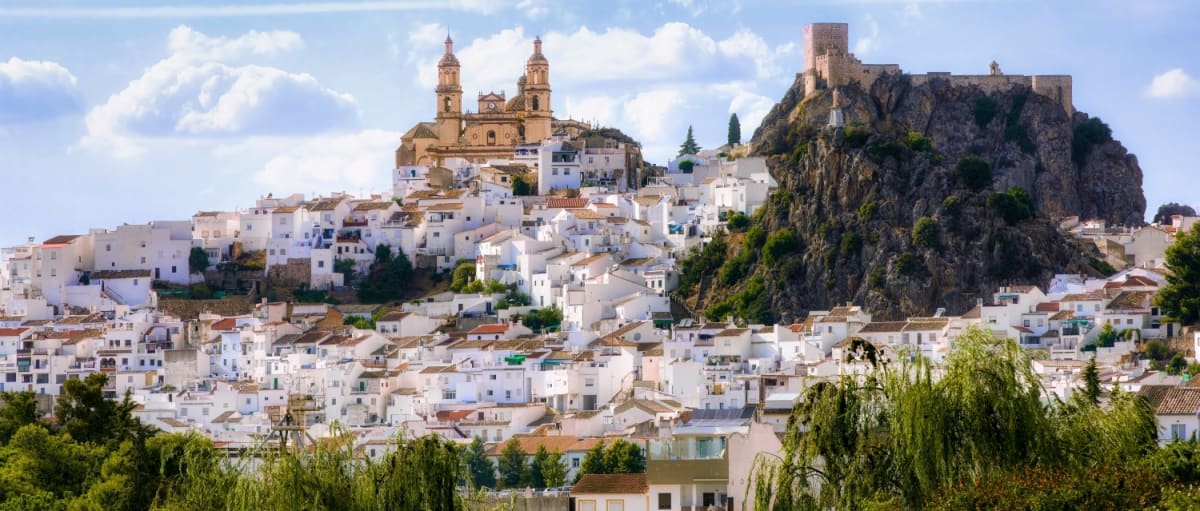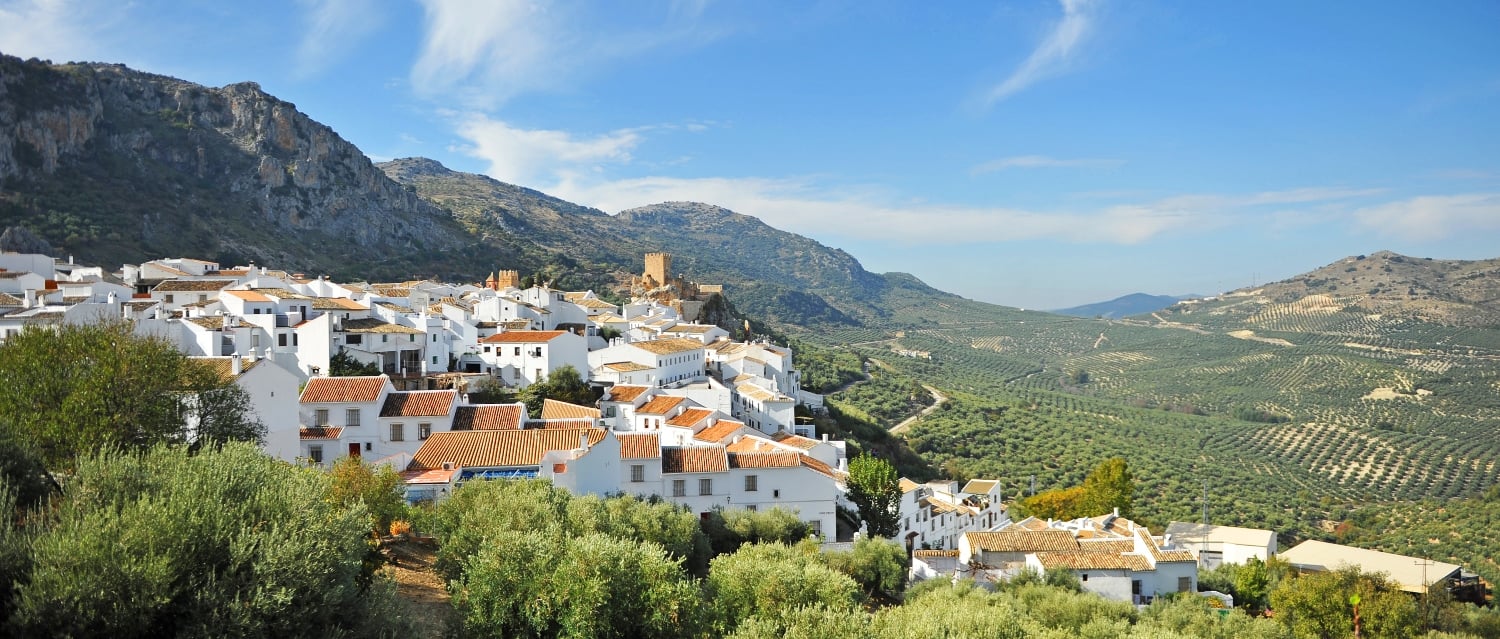While the coasts of Spain attract the majority of people seeking to buy a new property, be it for permanent living or as a second home, inland Spain offers a more tranquil and authentic way of life.
Andalusia in the south of Spain is one of the most popular regions with home buyers. In fact, around 20% of all property bought in Spain is in Andalusia [1]. Spanish people and foreigners flock there because of the climate and its varied landscapes stretching from the Mediterranean to the Atlantic.
The bustle of coastal towns isn’t for everyone, and there is much to enjoy moving inland, where property is cheaper, the views of olive trees and vines never fail to please, and genuine Spanish culture is found.
Let’s look at seven interesting places to consider for your new home:
Download the Spain Buying Guide
Antequera
A truly Spanish town, Antequera is a 49 minutes’ drive from Málaga airport and under an hour from the train station. When you drive into Antequera you are greeted by the impressive bullring at the edge of town which sets the scene for the delightful centre with shady squares and low-level buildings, white houses, an imposing Moorish fortress and a variety of excellent local restaurants.
It is a lively place and boasts a Parador hotel. In summer it is cooler and drier than on the coast which can get pretty humid. Temperatures are in the low 30s in August, but it does get chilly in winter. The population of this wealthy town is just over 41,000 with a small British community. Nearby are six lakes where you can enjoy water sports, swimming, picnics and nature.
Antequera would be an ideal location for those who prefer to live in “real” Spain, with Málaga not far away. A working knowledge of Spanish will make life easier, especially if you are seeking employment. It is a town with something for everyone, a gentle pace of life, history, culture, entertainment and a good quality of life.
Search properties in Antequera
The Alpujarras
The Alpujarras is a picturesque region located on the southern slopes of the Sierra Nevada mountains. Known for its dramatic landscapes, whitewashed villages and terraced hillsides, the area offers a unique blend of natural beauty and cultural heritage. Steeped in Moorish history, the Alpujarras retain a distinct charm, with traditional architecture, winding lanes and vibrant local customs. It is a haven for walkers, nature lovers and those seeking a tranquil escape into rural Spain.
This is the perfect location for people who want to get close to nature, be self-sufficient and live away from overcrowded areas. Those who enjoy an ecological lifestyle will feel at home here. Lanjarón is a spa town, Órgiva is the biggest hippie commune in Spain, Trévelez is known for its hams, Capiliera, a village high up with extensive views, is a Cultural Heritage Site, Bubión is located in the Sierra Nevada National Park and Pampaneira is all about Berber architecture. Other, smaller villages and hamlets are dotted around and nearby you can find fincas with plenty of land at reasonable prices.
Access to the Alpujarras, a mountainous region is relatively straightforward, though the terrain means travel is mostly by road. The main gateway is the city of Granada, located about an hour’s drive away. From there, well-maintained mountain roads lead into the heart of the region, with the A-348 and A-4132 being the primary routes.
Public transport is available, with regular bus services running from Granada to key villages such as Lanjarón, Órgiva and Trevélez, although services can be limited in more remote areas.
Subbética Cordobesa
The Subbética Cordobesa, or Sierra Subbética, is a mountainous area in the south of the province of Córdoba, Andalusia. Known for its rugged terrain, traditional villages and olive-covered hills, the region forms part of the Sierras Subbéticas Natural Park. It’s a place where nature and rural life go hand in hand, offering a quiet escape with opportunities for walking, cycling and exploring local culture. Towns like Priego de Córdoba, Cabra, and Zuheros reflect the area’s deep historical roots and connection to the land.
It is another area for nature lovers and people wanting a quiet, rural lifestyle, where property is extremely reasonable. Access is convenient thanks to its central location in Andalusia. The region is well connected by road, with the A-45 and N-432 highways providing easy access from major cities such as Córdoba, Granada, Málaga and Seville – all within roughly an hour and a half to two hours’ drive. While there is no direct train service into the heart of the Subbética, nearby cities like Puente Genil and Lucena offer regional rail connections.
Guadix and the Hoya de Guadix

Guadix is a historic town located in the province of Granada, known for its unique cave dwellings and striking cathedral. Set within the Hoya de Guadix, a wide natural basin surrounded by the Sierra Nevada and other mountain ranges, the area has been inhabited since prehistoric times. The landscape is marked by its dramatic badlands, fertile plains and rich archaeological heritage. Today, Guadix and its surrounding area offer a fascinating mix of history, culture and natural beauty, with a strong connection to traditional ways of life.
In recent times, there has been increasing interest in this area from people wanting an alternative lifestyle. Access to Guadix and the Hoya de Guadix is straightforward and well-connected. The town lies just off the A-92 motorway, making it easily reachable by car from the major cities of Granada (around 45 minutes) and Almería. Regular coach services also link Guadix with surrounding towns and cities. For those travelling by train, Guadix has a railway station with regional connections, including routes to Granada and Almería.
Valle del Guadalhorce
The Valle del Guadalhorce is a fertile and picturesque valley located in the province of Málaga. Known as the “orchard of Málaga,” it is characterised by its citrus groves, olive trees and rolling hills. The Guadalhorce River runs through the valley, supporting both agriculture and wildlife. With its mix of rural charm and proximity to the Costa del Sol, the valley offers a peaceful contrast to the coast while remaining easily accessible. Traditional towns such as Álora, Coín and Cártama provide a glimpse into Andalusian life, set against a backdrop of natural beauty and cultural heritage.
The Valle del Guadalhorce is easy to reach, especially from the city of Málaga. You can drive there via the A-357 motorway, which connects Málaga to towns like Cártama, Pizarra and Álora. There are also regular train services from Málaga to Álora and buses that run to several towns in the valley. The area is about 30 to 40 minutes by car from Málaga Airport.
The Sierra de Aracena and Picos de Aroche
The Sierra de Aracena and Picos de Aroche is a mountainous region located in the north of the province of Huelva. It forms part of the Sierra Morena and is known for its rolling hills, lush forests of cork and holm oak and traditional whitewashed villages. Much of the area lies within a protected natural park, making it a haven for walkers, nature lovers and those seeking peace and quiet. The town of Aracena, with its impressive cave system and historic castle, serves as a path to the region’s rich natural and cultural heritage.
The Sierra de Aracena and Picos de Aroche Natural Park is accessible by various means. From Seville, take the A-66 motorway. The park lies along this route. Regular bus services operate from Seville to towns within the park, such as Aracena. From Huelva, you can reach the park by train or bus, with journeys taking around two hours and 20 minutes. The nearest major airport is Seville Airport.
Conclusion
In conclusion, inland Andalusia is a varied and culturally strong area with natural parks, lakes, white villages, olive groves and mountains. You will need to speak some Spanish to survive in the smaller towns and villages. Generally, access to all the places mentioned is fairly easy and property prices are considerably lower than on the coast.
Search properties in Andalusia
Sources:
[1]: https://www.thepropertyfinders.com/property-market-reports/andalucia-market-report-2025









